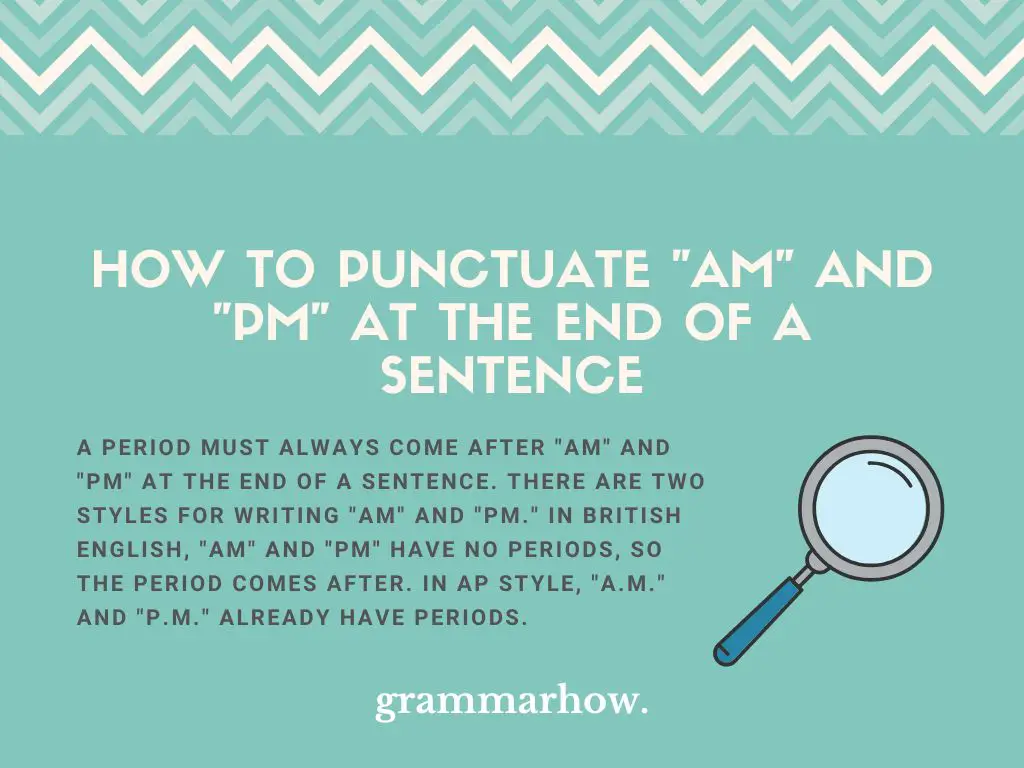Punctuating certain structures like “am” or “pm” in a sentence can be tricky. When periods are already present in certain writing styles (i.e. 11 a.m. or 1 p.m.), you might be stuck placing them at the end of a sentence. This article will explain how they work.
How to Punctuate “am” and “pm” at the End of a Sentence
A period must always come after “am” and “pm” at the end of a sentence. There are two styles for writing “am” and “pm.” In British English, “am” and “pm” have no periods, so the period comes after. In AP Style, “a.m.” and “p.m.” already have periods.

When periods already exist in words like “a.m.” or “p.m.,” they do twice the work. First, they act as a period to end the acronym. Second, if they come at the end of the sentence, the period also works as the usual sentence-ending punctuation point.
Here are two examples to show you the different styles you can use:
- I want to see you at 3 am.
- You told me that it was happening at 4 p.m.
Period after “a.m.” and “p.m.” at the End of a Sentence?
You do not need to place a period after “a.m.” or “p.m.” because the period is already present in the acronyms. You must keep the period after the “m” in each form, though. This acts as the sentence ender as well as the end of the acronym.
You might find that “a.m.” and “p.m.” are capitalized in some styles. Even still, “A.M.” and “P.M.” follow the same grammatical structures.
You should include them at the end of a sentence and treat the period at the end of them as the sentence ender:
- It’s going to be a long day. We’re here until 9 p.m.
- She wanted to see me at 3 p.m.
- It was supposed to happen at 10 a.m. It was postponed.
- You needed to be here at 6.15 P.M. Why weren’t you?
- It’s 10 A.M. Get to work!
Period after “am” and “pm” at the End of a Sentence?
When periods are not included in “am” or “pm,” you must include one after them if they fall at the end of the sentence. This acts as a normal period that ends the sentence.
You should also include the period when “AM” and “PM” are capitalized. Different writing styles will have them like this, so it helps to remember that before you start including them incorrectly.
These examples will show you how to use them in a sentence:
- I’m not going to get there for 10 AM.
- It was supposed to be 3 pm.
- She wanted to see me at 7:30 pm.
- They met at 12 PM. That’s all I know.
- It was 9 AM.
Punctuation when Sentence Ends with Question Mark
When a question mark is used, it must come after the period in the “a.m.” or “p.m.” formats. This means that a period and a question mark will be next to each other. With “am” and “pm,” you simply place the question mark after the “m.”
- Are you going to be there at 10 p.m.?
- What do you think about 5 pm? Is that too early to do this?
- Would you be able to make 4:30 p.m.? I’m just checking to see if that’s okay.
- Can we do 10 am? I need to clear a few things from my schedule.
- Is the meeting at 9 a.m. or 10 a.m.? I always forget these things.
Punctuation when Sentence Ends with Exclamation Mark
The exclamation mark must come directly after the period when using the “a.m.” and “p.m.” styles. “Am” and “pm” do not have periods, so the exclamation mark comes straight after the “m” (just like any other word that ends a sentence).
- It’s supposed to happen at 5 pm! I’m not going to be able to make it later!
- She wanted to get here at 12 p.m.! I told her that wasn’t going to be feasible.
- It’s 9:30 pm! Did you really think that people wouldn’t mind if you were being loud?
- You told me to see you at 3 a.m.! It’s no wonder that I’m as tired as I am! Why did you say that time?
- It’s 1 pm! It’s time for us to move! Come on; we need to see what we can do about this!
Final Thoughts
If you write “a.m.” and “p.m.” with periods, you don’t need to include a second period at the end of the sentence. The period already ends the sentence. In the “am” and “pm” styles, you must include a period after the “m” if the word ends the sentence.

Martin holds a Master’s degree in Finance and International Business. He has six years of experience in professional communication with clients, executives, and colleagues. Furthermore, he has teaching experience from Aarhus University. Martin has been featured as an expert in communication and teaching on Forbes and Shopify. Read more about Martin here.

